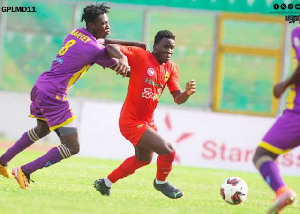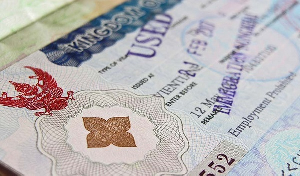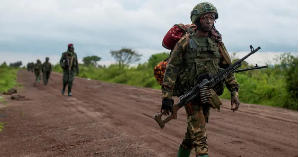...Police Supt., State Attorney, Immigration Boss have questions to answer
... As Noble Dosso’s name pops up Different angles continue to emerge in the on-going investigations into the cocaine scandal with names of different people also emerging on daily basis as being the architects of the new angels to the drug menace. The latest is the controversy over the entry into the country, of a suspected drug baron, without Immigration records on him.
Information available to The Chronicle, suggest that some key officials have concealed certain vital facts that may help to unravel the mystery over how Joel Mejia Duarte Mosies, the suspected Venezuelan drug baron, entered into the country through the Kotoka International Airport (KIA) without the knowledge of Immigration officials at the Airport.
Documentary evidence exclusively available to this paper points to two key people who may serve as useful witnesses to the Georgina Woode Committee in helping to uncover the machination that aided the suspected drug baron, currently facing trial, to outwit Immigration surveillance at the KIA when he arrived in the country on September 9, 2005.
The two people involved are Eric Francis Amison Agboloso who was until recently, the Chief State Attorney and Mr. Noble Dosso, husband of Rosa Iris popularly called Roseta, who was the secretary of COMPIMCHEX Ltd, a company that was established by the Venezuelan Cocaine fugitive, Vasquez Duarte Gerardo David and his Dutch partner, Vincente Croese.
A document dated May 16, 2006 signed by Mr. Agboloso on behalf of the Attorney General (AG) and Minister of Justice and addressed to the Director General of the Criminal Investigations Department (CID) of the Ghana Police Service, copied to the Inspector General of Police (IGP) and the Rapid Response Unit (RRU) section at Police Headquarters, mentions Dosso as the one who was contacted by Vasquez to facilitate Joel Mosies’ entry into the country.
“Evidence from Noble Dosso indicated that the said Vasquez told him the first suspect Mejia Joel will be in Ghana and solicited the assistance of the said Noble Dosso to facilitate Mejia entry into the country,” Agboloso’s document to the Police contained.
Agboloso’s document, with serial number XA184/200 continued, “Vasquez signed certain entry documents to that effect and Noble Dosso handed Mejia Joel to Vasquez at the Airport and Mejia was taken home by Vasquez who accommodated him until his arrest.”
Agboloso’s statement clearly indicates that he may have evidence on how Dosso aided the suspected drug baron to get out of the Airport. Dosso, who is said to be currently living in Tema, would also be a good witness in helping to get to the bottom of Mosies’ mysterious entry into the country.
The Chief State Attorney’s document was a response to a Police RRU/CID Headquarters duplicate case docket No. R.O. 93/05 that was forwarded to the A-G for study and necessary action.
Subsequently, Mr. Agboloso was queried on June 20, 2006 for what in the opinion of the A-G, was an action seeking to exonerate Joel Mejia and Italo Gervasio Resero Castillo who had been arrested in connection with the East Legon Cocaine case.
Despite having Agboloso’s document, police officials who had appeared before the Georgina Woode Committee have acted as though they were not aware of any evidence that could help state officials unravel the mystery surrounding Mosies’ entry into the country through KIA.
Earlier, Superintendent Edward Tabri had indicted the Ghana Immigration Service (GIS) for not being able to have any records on someone who had entered into the country illegally, through the KIA.
Following Tabri’s indictment, the former GIS official in charge of operations at the KIA, Mr. Fredrick Coleman, appeared before the Committee. In his testimony, Coleman indicated that it was possible for someone to come into the country without having his or her records captured by Immigration officials.
The assertion of the former GIS operations officer was however sharply contrasted by an official release from the Public Affairs Directorate of the Ghana Civil Aviation Authority (GCAA) yesterday. The GCAA release suggested that it was not possible for someone to enter into the country through the KIA legitimately or otherwise without being registered in the records of the Airport Immigration portraying that if it happens, then it should be considered as a security lapse on the part of Immigration officials.
The release said it was also not true that travelers could easily evade immigration procedures through several entry points to the airside of the Airport.
The release said there were also strict procedures concerning immigration processes for travellers using the VIP Lounge saying, "immigration officers need not necessarily be stationed at the Lounge". It said Mr Coleman's claim that travellers could evade immigration procedures by making use of one of several entry and exit points to the airside of the Airport was not true.
The release further noted that there had also been no record of complaints from any person for the absence of immigration officers at the VIP Lounge as Mr Coleman alleged.
The release said procedures at KIA were absolutely in line with Article 23 of the Chicago Convention of 1944 on international civil aviation.
There have therefore been calls for the need to have the head of the GIS, Elizabeth Adjei, appear before the investigation Committee to explain the security lapse on the part of her institution.
It has also been argued that since Superintendent Tabri was the police officer who led the operations for the East Legon Cocaine arrest and was at the time the head of the police RRU, a unit to which Agboloso’s document was copied, he may be a useful witness to the Committee in helping to uncover the mystery surrounding the entry of Joel Mejia into the country.
Click to view details



General News of Thursday, 17 August 2006
Source: Chronicle
Cocaine Plot Deepens: Why JAK is mad
Opinions
















